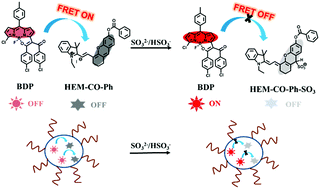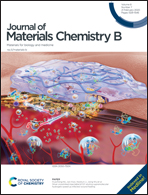A FRET-based supramolecular nanoprobe with switch on red fluorescence to detect SO2 derivatives in living cells†
Abstract
SO2, an important gasotransmitter, plays significant roles in human physiological activities. The reported probes for the detection of SO2 derivatives are mostly based on the quenching or blue-shift of fluorescence, leading to interference from the background signal. Herein, we develop a novel FRET-based nanoprobe that shows turn-on fluorescence at 615 nm in the presence of SO32−/HSO3−. The nanoprobe consists of N,O,B-chelated dipyrromethene (BDP) as the energy donor, and hemicyanine derivatives of HEM-CO-Ph with a responsive site to SO32−/HSO3− as the energy acceptor. Initially, the fluorescence of BDP is quenched by HEM-CO-Ph due to the efficient FRET process. In the presence of sulfites, the nucleophilic addition interrupts the conjugation of HEM-CO-Ph and results in a 200 nm blue-shift of the absorption, leading to the suppression of the FRET process and recovery of the red fluorescence of BDP. The nanoprobe shows fast response to SO32−/HSO3− with high selectivity, great biocompatibility and cellular uptake. It is the first supramolecular nanoprobe for the detection of SO32−/HSO3− by using intermolecular energy transfer, ingeniously turning the nanoprobe from “OFF” state to “ON” state. The nanoprobe is applied to monitor exogenous and endogenous SO2 derivatives in the mitochondria of living cells.



 Please wait while we load your content...
Please wait while we load your content...